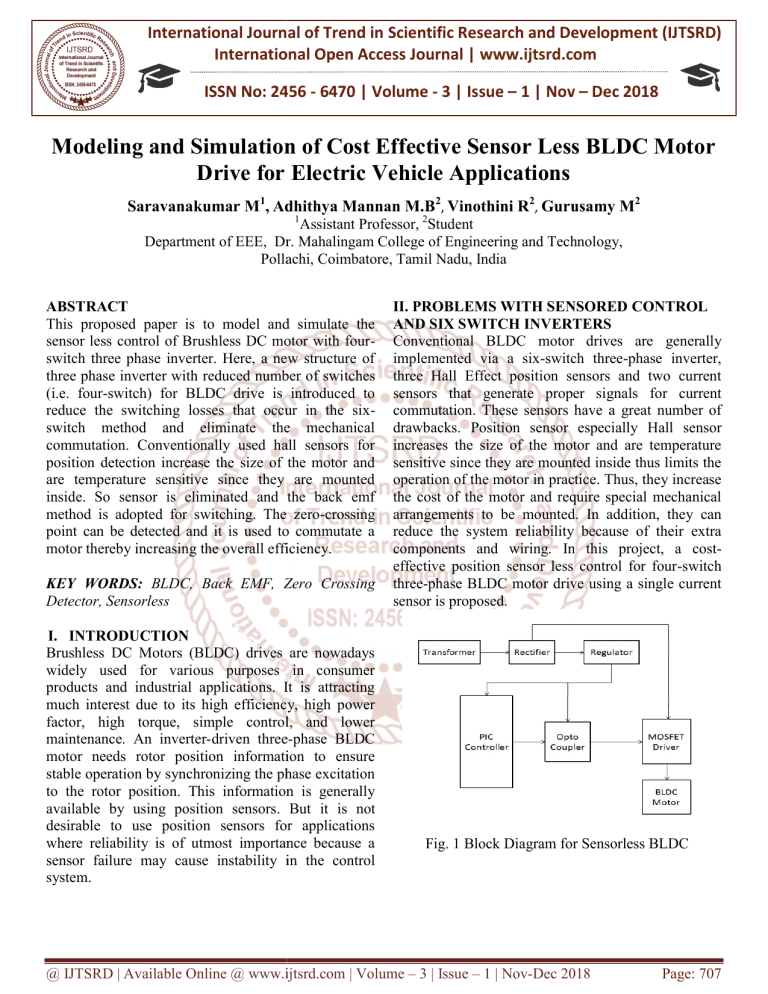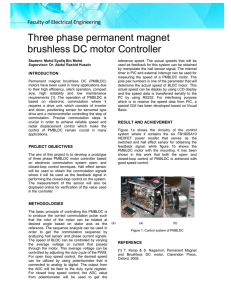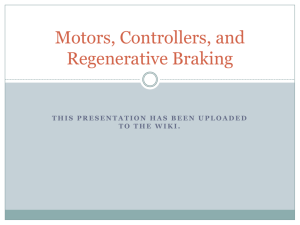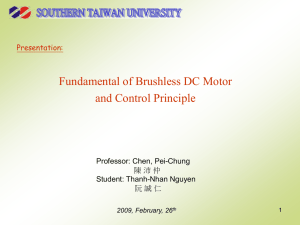
International Journal of Trend in Scientific Research and Development (IJTSRD)
International Open Access Journal | www.ijtsrd.com
ISSN No: 2456 - 6470 | Volume - 3 | Issue – 1 | Nov – Dec 2018
Modeling and Simulation of Cost Effective Sensor Less BLDC Motor
Drive for Electric Vehicle Applications
Saravanakumar M1, Adhithya Mannan M.B2, Vinothini R2, Gurusamy M2
1
Assistant Professor, 2Student
Department of EEE, Dr. Mahalingam College of Engineering and Technology,
Pollachi, Coimbatore, Tamil Nadu, India
ABSTRACT
This proposed paper is to model and simulate the
sensor less control of Brushless DC motor with four
fourswitch three phase inverter. Here, a new structure of
three phase inverter with reduced number of swi
switches
(i.e. four-switch)
switch) for BLDC drive is introduced to
reduce the switching losses that occur in the six
sixswitch method and eliminate the mechanical
commutation. Conventionally used hall sensors for
position detection increase the size of the motor and
aree temperature sensitive since they are mounted
inside. So sensor is eliminated and the back emf
method is adopted for switching. The zero
zero-crossing
point can be detected and it is used to commutate a
motor thereby increasing the overall efficiency.
KEY WORDS: BLDC, Backk EMF, Zero Crossing
Detector, Sensorless
I. INTRODUCTION
Brushless DC Motors (BLDC) drives are nowadays
widely used for various purposes in consumer
products and industrial applications. It is attracting
much interest due to its high efficiency, high power
factor, high torque, simple control, and lower
maintenance. An inverter-driven
driven three
three-phase BLDC
motor needs rotor position information to ensure
stable operation by synchronizing the phase excitation
to the rotor position. This information is generally
available by using position sensors.. But it is not
desirablee to use position sensors for applications
where reliability is of utmost importance because a
sensor failure may cause instability in the control
system.
II. PROBLEMS WITH SENSORED CONTROL
AND SIX SWITCH INVERTERS
Conventional BLDC motor drives are generally
implemented via a six-switch
switch three-phase
three
inverter,
three Hall Effect position sensors and two current
sensors that generate proper signals
si
for current
commutation. These
hese sensors have
h
a great number of
drawbacks. Position sensor especially Hall sensor
se
increases the size of the motor and are temperature
sensitive since they are mounted inside thus limits the
operation of the motor in practice. Thus, they increase
the cost of the motor and require special mechanical
arrangements
ents to be mounted. In addition,
add
they can
reduce the system reliability because of their extra
components and wiring. In this project, a costcost
effective position sensor less control for four-switch
four
three-phase
phase BLDC motor drive using a single current
sensor is proposed.
Fig. 1 Block Diagram for Sensorless BLDC
@ IJTSRD | Available Online @ www.ijtsrd.com | Volume – 3 | Issue – 1 | Nov-Dec
Dec 2018
Page: 707
International Journal of Trend in Scientific Research and Development (IJTSRD) ISSN: 2456-6470
2456
III. PROPOSED FOUR-SWITCH
SWITCH THREE
PHASE INVERTER BRUSHLESS DC MOTOR
DRIVE
Usually, Brushless DC motors are excited by Six
Sixswitch three phase inverter, have lot of Commutation
Problems and Switch Leg failure and large amount of
Switching Losses. The three-phase
phase inverters with only
four switches, is striking
triking solution for Six
Six-Switch
Inverter to reduce mechanical Strength and Switching
Losses. In additional to that with the normal three
threephase voltage-source
source inverter with Four switches, the
most important descriptions of this proposed
converter plays dual role, i) the first is the reduction
of Switches and Freewheeling diode count; ii) the
second is the reduction of conduction losses.
Table 1 Switching sequence of four-switch
f
three
phase inverter
Mode
Active Phases
Silent Phases
1
B and C
A
2
A and B
C
3
4
5
A and C
B and C
A and B
B
A
C
6
A and C
B
IV. BACK EMF COMPENSATION
As three-phase
phase Brushless DC motor is motivated with
six-step 120˚ control process. Therefore, the
conduction interval of one phase is 120˚.
120 The BackEMF zero-crossing
crossing detecting performance is based on
only two phases of a Brushless DC Motor. When
phase A and phase B are connected to the source,
phase C is floating. No current is going through this
phase. This conducting interval lasts 60 electrical
ele
degrees, which is called commutation
ommutation step. This is
described by the following conditions:
Fig. 2 Four Switch three phase inverter
In proposed method single phase to three phase
converters back end consists of four switches (T1 to
T6). In three phase Brushless DC motor, two phases
A and B are connected to the two legs of the Four
Fourswitch three phase inverter and the third phase C is
connected
cted to the centre point of the capacitor. Phase C
is directly connected to the Brushless DC motor, so
the phase C current is not directly controlled
controlled.
Sa + Sb + Sc =0
(1)
Sc=-(Sa + Sb)
(2)
Therefore, phase C indirectly controlled by phase A
and phase B. For Brushless DC motors with a
trapezoidal back EMF, is required to produce a
constant electric torque. The proposed voltage Pulse
Width Modulation (PWM) scheme for Four
Four-switch
three phase inverter requires six commutation modes
which are (X, 0), (1,0), (1, X), (X, 1), (0, 1) and (0,
(0,X).
Here “X” stands for don’t care conditions.
Fig. 3 Simulink Model of Proposed System
If A phase High, B phase Low: which is analysed as
general equations.
Normally,
£a + £b + £c = 0
(3)
Va = 3/2ew+ Vdc/2
(4)
Vb = 3/2ew+ Vdc/2
(5)
Vc = 3/2ew+ Vdc/2
(6)
In these equations, forward voltage drop of Insulated
bipolar transistor and freewheeling diode is ignored.
However, in the four-switch
tch converter based on the
four-switching operation, the generation of 120˚
120
conducting and a 60˚ non-conducting
conducting current profile
is essentially complicated. That resource the
conventional Pulse width modulation schemes
@ IJTSRD | Available Online @ www.ijtsrd.com | Volume – 3 | Issue – 1 | Nov-Dec
Dec 2018
Page: 708
International Journal of Trend in Scientific Research and Development (IJTSRD) ISSN: 2456-6470
2456
employed for four-switch
switch induction motor drives
cannot be directly applied to Brushless
rushless DC motor
drives with sensor less. This lead to the improvement
of a novel control scheme called Direct Current
Controlled Pulse width modulation scheme
scheme.
It is carried out by voltage and time period and the
results are taken from Simulink environment. The
Stator Current signals generated by the switches from
the output of controller are shown in fig 6.
V.RESULTS AND DISCUSION
The simulation of proposed research four
four-switch
Brushless DC Motor is carried
ed by Simulink and its
Simulink model are shown in fig 3.To
To generate the
pulse width modulation signals Subsystems of the
proposed converter is shown in fig 4.
Fig. 6 Current Signals of phase A, B, C
The Torque and Speed curves generated by the
switches from the output of controller are shown in
fig 7.
Fig. 4 Subsystem of four switch inverter
The reference speed is set and rotor position sensor
speed sensed are given to the controller.
er. If it is equal
it is send to the controller
oller or error is generated and
rectified and it is given to the controller then the
switches generate the Pulses. The Back eemf signals
generated by the switches from the ou
output of
controller are shown in fig 5.
Fig. 5 Back Emf of phase A, B, C
Fig. 7 Torque and Speed Characteristics
VI. CONCLUSION
Brushless DC drives is preferable for compact, low
maintenance and high reliability systems.
system In order to
reduce the mechanical strength it proposed that
without sensors and simulations were carried out. The
simulation of the brushless DC motor is done using
the software MATLAB/SIMULINK.
MATLAB/SIMULINK Back EMF,
phase voltage, phase current, rotor speed waveforms
waveform
are analysed for the speed of rotor is 800 rpm. In this
proposed converter uses less number of insulated
bipolar switches which evaluate the difference from
conventional converter. The
he back electromotive force
compensating and direct current controlling for
brushless DC motor drive was analysed and switch
leg failure was avoided. Pulse
P
width modulation
@ IJTSRD | Available Online @ www.ijtsrd.com | Volume – 3 | Issue – 1 | Nov-Dec
Dec 2018
Page: 709
International Journal of Trend in Scientific Research and Development (IJTSRD) ISSN: 2456-6470
2456
scheme can eradicate the offset voltage in the back
electromotive force signal caused by the voltage drop
of the insulated bipolar transistor and also increase
system efficiency by reducing the conduction loss is
achieved.
ved. There are no hall sensors and therefore the
system becomes
ecomes robust, optimized design, higher
efficiency and better speed.
References
1) G. Paranjothi, R.Manikandan “Photovoltaic Based
Brushless DC Motor Closed Loop Drive for
Electric Vehicle” International Journal of
Emerging Trends in Electrical and Electronics
(IJETEE – ISSN: 2320-9569)
9569) Vol. 10, Issue. 1,
Jan-2014.
2) M. Ebadpour, M. B. B. Sharifian, M. R. Feyzi
Feyzi, “A
Cost-Effective Position Sensor Less Control for
Four-Switch Three-Phase
Phase Brushless DC Motor
Drives Using Single Current
nt Sensor” International
Review of Automatic Control (I.R.E.A.CO.),
E.A.CO.), Vol.
4, N. 3 May 2011.
3) Sathish Kumar Shanmugam, Meenakumari
Ramachandran, Krishna Kumar Kanagaraj,
Anbarasu Loganathan, “Sensor less Control of
Four-SwitchInverter
Inverter for Brushless DC Mot
Motor
Drive and Its Simulation”, International
conference of Circuits and Systems ,,May 2016.
4) Abolfazl Halvaei Niasar, Abolfazl Vahedi, Hassan
Moghbelli , “Low-cost
cost sensor less control of fourfour
witch, Brushless DC motor drive with direct backEMF detection” Journal of Zhejiang University
Univers of
Science (ISSN 1673-565X),
565X),2009.
5) Praveen Kumar C, Sobi Soman,
Soman “Simulation of
Four Quadrant Operation of Sensor less BLDC
Motor” Journal of Electrical and Electronics
Elec
Engineering (IOSR-JEEE)
JEEE), 2015.
6) Bolfazl, H.N., “A
A Novel Position Sensorless
Control of a Four-Switch,
Switch, Brushless DC Motor
Drive without Phase Shifter”,
Shifter IEEE Transactions
on Power Electronics, 23, 3079-3087,2008
3079
7) Damodharan, P. and Vasudevan, K.,
K. “Sensor Less
Brushless DC Motor Drive Based on the ZeroCrossing Detection of Back Electromotive Force
(EMF) from the Line Voltage Difference”,
Differe
IEEE
Transactions on Energy Conversion, 25, 661-668,
2010
8) Adauria, Y., Patel,, A.N., Patel, V. and Patel, J,
“Simulation
Simulation and Analysis of Three Phase Voltage
Source Inverter Using Four Semiconductor
Switches”.. Nirma University International
Conference on Engineering (NUiCONE),2012.
(NUiCONE)
@ IJTSRD | Available Online @ www.ijtsrd.com | Volume – 3 | Issue – 1 | Nov-Dec
Dec 2018
Page: 710






